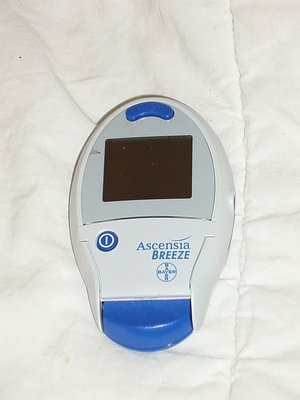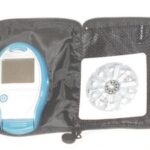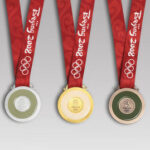The Ascensia Breeze Diabetes Meter, made by Bayer, incorporates a new feature that is its ‘claim to frame’. Instead of individual test strips, it utilizes a ten test “autodisc” that is inserted once and carried internally in the meter. This allows for ten consecutive blood glucose measurements before there is a need to insert another disc. Bayer’s massive advertising campaign describes this as avoiding the need to “fumble with awkward little strips” for each measurement, and eliminating steps from the measurement process. The meter is automatically calibrated to the disc, and each measurement requires only the skin puncture and then a push-pull movement to expose the tip of the sampling device. The sampling itself is relatively simple as a very small sample, less than a microliter, is automatically pipetted up into the device. Thus, one or two steps involved in finding, inserting, and validating the code of the strip are, indeed, eliminated. Is this easier than competing meters? Yes. Is it a lot easier and an important feature? Well, maybe, but there are some other considerations to weigh. Let’s describe this device.
The meter itself is a relatively bulky appliance (compared to modern meters), measuring about 11 ½ X 4 ½ cm. (roughly 4 ¼ X 2 inches), and about 2 ½ cm. (1 inch) thick. However, this size is deliberate and not entirely disadvantageous; it is easier for arthritic hands to manipulate than the very small meters. Compared to the trend toward incredibly complicated meters that can correlate your blood sugar measurements with everything from you mood and activity level to your horoscope or anything else you want to put into them. The Breeze has no mechanism for keeping track of such niceties, and is, therefore, advertised as “simple to use.” Of course you can just not use these features in the more complicated meters, either, if you wish to simplify them; they merely offer the option.
The Breeze will hold a memory of 100 measurements, fewer than some, and won’t provide the option of the fancy correlations and curves that can be displayed by the more complex alternatives (see the review of the Ultrasmart, for example). However, it will allow you to download these 100 values to your computer, where you can generate curves to your heart’s content, although it does not keep track of the physical conditions or other variables that you can put into the fancier meters, which limits the potential analyses. These are, theoretically helpful and actually a good idea in the more fragile diabetics, but they are rarely used to full advantage, anyway.
The Breeze comes in a convenient, zippered cloth case that is only slightly larger than the meter itself. The case holds the meter, the lancet device that is supplied with it, and some varying number of lancets and discs; a few of the former and five of the latter are supplied in the original kit. Preparation for testing was, indeed, relatively simple. The insertion of the ten test disc was only slightly more cumbersome than retrieval and insertion of individual strips in other meters, and, of course, it need only be done once for every ten measurements. Of the ten, on that first disc, I experienced two failures of measurement, a somewhat high percentage for such things, but it was my first experience with the procedure, and, although it is relatively simple, there is still some procedural behaviors that must be learned to minimize failures. With practice, the failure rate quickly dropped well below 10%, comparable to, or better than most other meters. There was one difference, however, that did not compare well to most modern glucometers. The countdown to the result was about 30 seconds, six times as long as the meters I normally use. As a result, the entire procedure from getting the lancet to getting the result was about twice as long with the Breeze as it was for the One Touch UltraSmart or Ultra 2 that I usually use. For me, this more than compensates for the reduction in number of steps that the procedure requires.
Actually, there are circumstances in which the freedom from needing to find and extricate the measuring strips is enough of an advantage to make it worthwhile, such as in restricted or low light situations, for example sitting in a movie theater, in which finding the strips, removing them from the can, and inserting them is awkward. Simply pulling back the lever on the meter is substantially easier. With the backlighting feature that almost all of the meters have, allowing measurement in low light environments, the added convenience of the Breeze can be important and the extra wait for the results is relatively trivial.
The small sample size is useful for several reasons. For one thing, it is sometimes difficult to get a substantial drop of blood, particularly in children. For another thing, it allows sampling from sited other than fingers which have more nerve endings (and capillaries) than many other places on the skin. However, the resulting values are not identical and should be interpreted under the direction of a professional. The advertised sample sizes are somewhat misleading, anyway. Although the actual sample analyzed is less than a microliter, more blood than that is always required for the procedure. Moreover, in meters that required even less of a sample than the Breeze, I found substantial inaccuracies and unreliabilities. However, this is not true of the Breeze. This sample appears to be always accurately drawn, and in substantial tests against standards and meters of known accuracy, I found the Breeze to be comparable to the two most accurate meters I have ever tested, the One Touch UltraSmart and the One Touch Ultra 2.
The used test ‘strip’ that needs to be discarded after each use is quite small. Although this is, in some ways, advantageous, it must be remembered that this item is, technically, hazardous biological waste and should be disposed of properly, in a container for such purpose. This is, of course, also true of the lancets and any insulin needles that the diabetic person might use. I must admit that this regulation is roundly ignored and few people, other than providers, maintain hazardous materials containers.In fact, I don’t know of any patient who complies with this regulation; I just thought it might be worth mentioning.
The Breeze is inexpensive, even if you want to pay for it for some reason. It’s easy enough to get free through one promotion or another, but if you insist on paying for it, it will cost you somewhere between $25.00 and $30.00, unless you buy it at some Yuppie mall. The manufacturers will take a loss on any meter because they make their money selling the outrageously overpriced supplies that you must use with it.
In summary, the Ascensia Breeze, by Bayer is a meter that is simple to use, slightly bulkier than others, but easier to handle as a consequence. Its size is not so great that it cannot drop conveniently into a purse or a pocket, and, when I go out of the house, I take advantage of the freedom from having to carry a can of strips by simply putting the meter itself (with a fresh disc already inserted) in my pocket and taking a couple of lancets. (You don’t really need the lancet device.) But for keeping in the house, I prefer either of the One Touch Glucometers mentioned above. The Breeze, makes a useful ancillary meter, but if I could only have one, for some reason, I would certainly choose the One Touch UltraSmart as my first choice and the Ultra 2 as my second.
As I was testing this meter, Bayer released The “Breeze 2” that corrects the major problem I had with this meter. It delivers the result in five seconds, which has become standard for the top meters. This necessitates changing the reagents and could, possibly, affect the accuracy. Given the very small sample used, this could be a concern, but my guess is that it retains the high accuracy of the model tested. However, I am in the process of obtaining this meter in order to test the reliability and accuracy. I shall report on the results of this test as soon as it is completed.




